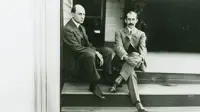Building through the ages: Kongō Gumi’s 1446-year journey
By Aniket Gupta | 01 Mar 2024
.jpg)
The world of business abounds with companies rising from scratch, some succeeding and lasting, most succeeding briefly or never to succeed, and shutting down. Entire industries too have risen, only to decline and die, even in our lifetimes, mainly due to the rapid evolution of technology.
According to the World Economic Forum, the average lifetime of a Fortune 500-listed business is about 40 to 50 years. For a small or medium-sized business, the average life expectancy is around 21 years. Startups have the worst luck; their life expectancy has been around 4-5 years.
In such a world of harsh competition and obsolescence, there is a company that stands out as a beacon of longevity. A company whose inception was closer to the fall of the Roman Empire than we are to the end of World War I. The company I am talking about is a modest family-run Japanese construction company called Kongō Gumi.
Since its establishment, Kongō Gumi has been a construction company specializing in constructing and restoring temples and shrines. The Kongō family has run the business for 40 generations!
.jpg)
The beginning
The tale of Kongō Gumi spans 14 centuries, starting in 578 AD, just over a century after the fall of the glorious Roman Empire. That was the time when ancient India was becoming a bustling hub of trade.
In the 6th century CE the majority of the population in Japan followed the Shinto religion. Shinto was a polytheistic and animistic religion, worshipping supernatural entities called the kami (god). Later, as the Japanese began to trade with other Asian peoples, many of them began to follow Buddhism, which came from India to Japan via China.
.jpg)
With the rise of Buddhism in the country, Prince Shōtoku Taishi of the Asuka period (552–644 CE) commissioned a project to build Japan’s first-ever Buddhist temple, Shitennō-ji.
But he had a problem. As Japan was mainly dominated by Shinto, they didn’t have miyadaiku (people or carpenters who specialized in building Buddhist temples). So Prince Shōtoku Taishi invited three skilled artisans from Baekje, a Buddhist-dominated state on the Korean peninsula. One of these three was Shigemitsu Kongō, who then established Kongō Gumi Company in Osaka, Japan.
.jpg)
The construction of Shitennō-ji started in 578 AD and was completed in 593 AD. Since then, the responsibility to maintain and restore the temple has been the responsibility of Kongō Gumi.
Over the following centuries, Kongō Gumi started to build temples all over the island country. Kongō Gumi made an impressive reputation for itself by focusing on building and restoring temples and shrines. As the work it was doing held a significant value in the culturally driven Japanese society, Kongō Gumi followed some strict business principles, which allowed it to survive for 14 centuries.
When tradition meets business
The Kongō family followed certain rules over the years. And it was the responsibility of the leader of the company to make sure these rules were passed down to future generations.
The organization had a very flexible way of appointing its leader. Traditionally, the head of the family is automatically considered to be the head of the family business. But Kongō Gumi had a very different approach. The person who was the most competent, the healthiest, and had the best carpentry skills, regardless of seniority, was selected as the leader of the company. In the event that there were no male heirs present to take over the company, the family would select the most competent son-in-law to take charge of the business.
.jpg)
Interestingly, the 37th leader of Kongō Gumi, Haruichi Kongō, had committed ritual suicide during the Shōwa Depression period (1930–31). The reason was that he was not able to provide well for his family and the families of his craftsmen. As, during that time, there was no suitable male leader for the company, Haruichi's widow, Yoshie Kongō, became the first and only female leader of Kongō Gumi. She brought in a lot of reforms to the company, starting with undertaking projects to build exquisite wooden coffins. She also created management positions to make it easier to manage the craftsmen. Her strong leadership helped the company survive and grow during a very turbulent time and ushered the company into the new post-industrial era.
.jpg)
Choosing the right successors was not the only reason for Kongō Gumi to survive this long. The very high quality of work done by Kongō Gumi craftsmen was another reason behind the company’s longevity. The 32nd leader of Kongō Gumi, Yoshisada Kongō, wrote a set of 16 precepts titled ‘Shokuke kokoroe no koto’ meaning ‘family knowledge of the trade’ during the Meiji Period (1868–1922). This set of rules clearly explains how the company survived for such a long time.
As mentioned before, one of the reasons behind the company’s longevity is the very high quality of work done by its craftsmen. A new employee of the company must spend ten years as an apprentice perfecting his craft before he can take on an actual project.
The craftsmen of Kongō Gumi were also divided into different groups known as ‘kumi’, who then competed against each other to prove their superiority in their craft.
Shokuke kokoroe no koto also mentions some other rules the company must follow to keep its millennia-long tradition intact. The company always wants its leader to respect its customers and listen to what they say. The leader must always give the most honest and cheapest estimate possible for any project.
Kongō Gumi has always wanted to prioritize its passion for its craft rather than the money its clients pay. It also prioritized building solid and honest relationships with its customers to ensure long-term sustainability in times of economic hardship.
One very important culture set in Kongō Gumi is to always properly balance tradition with changing times. As building temples and shrines is considered traditional work, the company should also evolve according to changing times.
One big example of how Kongō Gumi evolved with changing times was during the Meiji Period (1868–1922) when Japan started westernizing. The revenues derived from restoring temples had dried up, and Kongō Gumi broke tradition and started to build residential and commercial buildings.
During that period, most of the temples were built using wood. Kongō Gumi was one of the first companies in Japan to use concrete along with wood to maintain the durability of temples. In the latter half of the 20th century, Kongō Gumi also became the first company in Japan to use CAD software to design temples.
Shitennō-ji temple and Kongō Gumi
As we saw earlier, Kongō Gumi was first established for the sole purpose of the construction of the prestigious Shitennō-ji temple. For more than a millennium, Kongō Gumi was tasked with the routine renovation of the temple – and the temple needed a lot of restoration work over the years.
.jpg)
In 1576, during the Sengoku Period (1467–1615), Oda Nobunaga attacked the city of Osaka and subsequently destroyed the Osaka castle and burned down the Shitennō-ji temple. After the devastation, Kongō Gumi immediately started restoring the temple. The company also helped rebuild the Osaka Castle during that period.
Then, in 1614, during the end of the Sengoku Period, Osaka was attacked again, this time by the Tokugawa shogunate clan, and the Shitennō-ji temple was burned down again. The Kongō Gumi were called upon again for their services to restore the temple.
In its entire lifetime, the Shitennō-ji temple has been rebuilt seven times, and every time it was one of the Kongō Gumi heads who was handed the job.
.jpg)
In 1934, during the Muroto typhoon, the Shitennō-ji Gojū-no-tō, a five-story pagoda inside the temple complex, collapsed completely. Kongō Gumi was again called to rebuild it under the leadership of Yoshie Kongō.
.jpg)
Shitennō-ji temple was last rebuilt in 1963, from which most of the structures are still standing today.
The 21st century and takeover
Since the 1990s, Kongō Gumi has faced a lot of troubles. Toshitaka Kongō, the 39th leader of the company, outlined some of the problems the company had faced in the post-industrial world. He stated that one of the major problems the company faced was that nobody wanted to wait 15 years for the construction of the temple to be completed. Hastening the process would mean neglecting the 1400-year-old tradition of high-quality construction. Kongō Gumi found it difficult to balance tradition with the evolution of modern practices from the 1990s and the 21st century.
In January 2006, the company faced financial difficulties, leading to its liquidation. Following this, the Takamatsu Construction Group acquired the company.
Before liquidation, Kongō Gumi still constructed temples and had a small workforce just around 100 employees. In 2005, its annual revenue was only ¥ 7.5 billion (around $70 million), and Masakazu Kongō, the 40th leader of the company, served as its last president. As of February 2023, Kongō Gumi continued to operate as a wholly-owned subsidiary of the Takamatsu Construction Group.
The tradition lives on
.jpg)
Although the company is now a shadow of its past self, the Kongō family and its workers still maintain temples as part of their tradition. On the 1st and 15th days of every month, more than 120 Kongō carpenters and staff assemble for a small prayer, offering their thanks to Prince Shōtoku Taishi and Shigemitsu Kongō, the people who started it all.



















